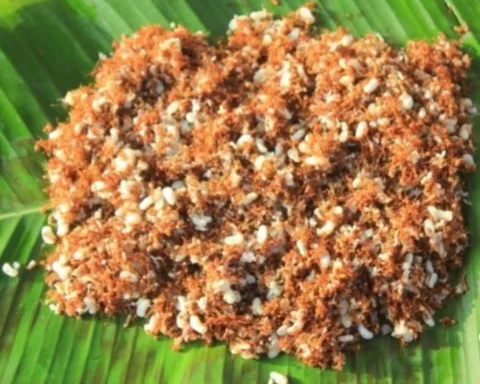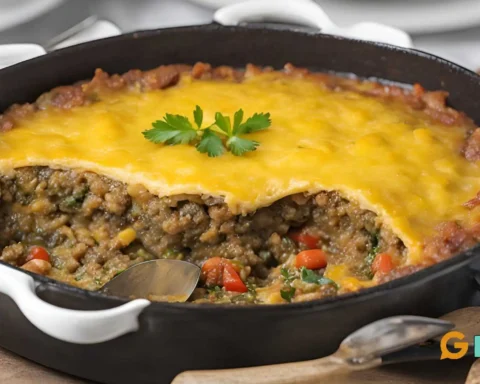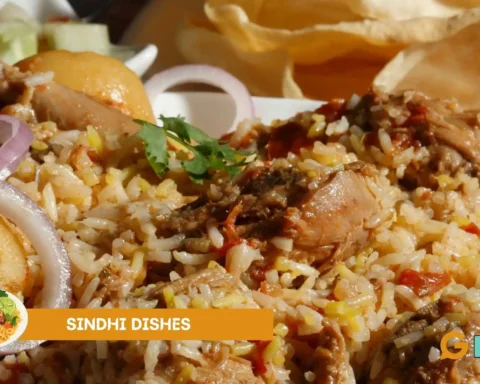Hold onto your taste buds because we're about to delve into the wild and wonderful world of Malewa – the dish that's rewriting the rules with a bamboo twist! Originating from East Africa, Malewa takes a delicious detour with bamboo shoots as its dazzling star ingredient, adding excitement to every bite.
Cooking up Malewa is like orchestrating a flavour symposium: These shoots are marinated to perfection and then braided with a kaleidoscope of aromatic spices. The result? A mouthwatering masterpiece that's hearty and zesty, making your taste buds break into a joyful conga line.
Table of Contents
History and Origin of Malewa
A few migrants from South Africa sought refuge in the caves of Mount Elgon or Mt. Elgon in the 16th and 17th centuries. Malewa, a dish renowned for its unique use of bamboo shoots, has its roots intertwined with the rich culinary heritage of East Africa, particularly in countries like Kenya and Uganda.
The history of Malewa dates back to traditional practices, where local communities harnessed the abundant bamboo resources in the region to create a distinctive culinary delight.
Bamboo shoots, known for their tender texture and ability to absorb flavours, were embraced by resourceful cooks who transformed them into delectable dishes. Over time, Malewa became a staple that satisfied hunger and celebrated the land's natural offerings.
As generations passed, this Ugandan dish evolved from a humble and practical meal into a cultural emblem. It reflects the ingenuity of African cooking, where local ingredients are celebrated and transformed into vibrant feasts. Today, Malewa serves as a delicious link to the past while also showcasing the innovative spirit that has always been at the heart of East African cuisine.
Preparation Before Cooking Malewa
Washing bamboo shoots thoroughly is essential to remove any residual dirt, debris, or harmful elements that might be present on their surface. Additionally, washing helps eliminate any remaining bitterness. It ensures the shoots are clean and safe for consumption, enhancing the overall flavour and quality of the dish.
To prepare bamboo shoots before cooking the Malewa dish, start by peeling away the tough outer layers using a knife or peeler, as they can be fibrous and bitter. Once peeled, slice the bamboo shoots into thin rounds or strips. Blanch the slices in boiling water with rock salt, baking soda, or ash for about 5 minutes to remove bitterness and partially cook them.
Drain the bamboo shoots and rinse them under cold water to halt the cooking process and retain their vibrant colour. With these steps completed, the bamboo shoots are ready to absorb the flavours of the spices and other ingredients as they become a delicious part of your Malewa dish.
Ingredients and Instructions for Cooking Malewa
Bamboo shoots are the primary ingredient of this dish, which celebrates the harmonious marriage of local ingredients and spices, creating a comforting and exotic culinary experience.
Malewa with Ground Nuts Recipe
Ingredients:
- 2 cups fresh bamboo shoots, cleaned, peeled, and sliced
- 1 cup groundnuts (peanuts), soaked overnight and drained
- 1 medium onion, finely chopped
- 2-3 tomatoes, diced
- 2 cloves garlic, minced
- 1 tablespoon ginger, minced
- 1 teaspoon ground coriander
- 1 teaspoon ground cumin
- 1/2 teaspoon turmeric
- 1/2 teaspoon paprika
- 1/4 teaspoon ground cinnamon
- 1/4 teaspoon ground cloves
- 1/4 teaspoon ground cardamom
- Salt to taste
- 2-3 tablespoons vegetable oil
- Fresh cilantro or parsley for garnish
Instructions:
Prepare the Bamboo Shoots: Follow the earlier steps to clean, peel, slice, blanch, and rinse the bamboo shoots.
Cook the Groundnuts: Boil the soaked groundnuts in water until they are soft and tender. Drain and set them aside.
Chop Aromatics: Finely chop onions, mince garlic and ginger, and dice tomatoes.
Prepare Spice Blend: Mix ground coriander, cumin, turmeric, paprika, cinnamon, cloves, and cardamom in a bowl.
Cooking the Dish: Heat the vegetable oil over medium heat in a large skillet or pot. Add the chopped onion and sauté until translucent and slightly golden. Add the minced garlic and ginger and sauté for another minute until fragrant.
Add the Spices and Tomatoes: Add the spice blend to the skillet and stir well to coat the onion mixture. Add the diced tomatoes and cook until they soften and release their juices.
Incorporate Bamboo Shoots and Groundnuts: Add the blanched bamboo shoots to the skillet and mix well with the tomato-spice mixture. Add the cooked groundnuts.
Simmer and Season: Reduce the heat to low and let the dish simmer for 15-20 minutes, allowing the flavours to meld together. Add salt to taste, adjusting the seasoning as needed.
Garnish and Serve: Once the flavours have melded and the bamboo shoots are tender, your Malewa with groundnuts will be served. Garnish with fresh cilantro or parsley.
Enjoy: Serve the Malewa sauce with groundnuts alongside steamed rice, chapati (flatbread), or Matooke(cooked green bananas), your favourite side dish. This dish tastes similar to forest mushrooms. Savour the unique combination of flavours and textures in this delightful twist on the traditional Malewa dish.
Variations in the Malewa
There can be variations to this delicious dish in terms of ingredients and preparation methods. The core of Malewa usually involves bamboo shoots and beans, but different regions and cultures may add their unique twists. Here are a few potential variations:
- Spices and Seasonings: The combination of spices and seasonings can vary widely. Some versions incorporate more heat with chilli peppers, while others emphasize milder aromatic spices like cumin, coriander, and cinnamon.
- Additional Ingredients: Some variations might include additional vegetables like bell peppers, carrots, or leafy greens to add texture and nutrition to the dish.
- Protein: While beans are a common protein source in Malewa, some variations might include meat, poultry, or seafood for added richness.
- Cooking Method: Malewa is traditionally simmered on a stovetop, but modern variations might involve pressure cooking or slow cooking to save time and enhance flavours.
- Presentation: Malewa can be served with various accompaniments like rice, flatbreads, or even as a side dish alongside other main courses.
- Regional Differences: Different East African countries might have their take on Malewa, incorporating local ingredients and flavours specific to their region.
- Vegan or Vegetarian: Depending on dietary preferences, variations might cater to vegans or vegetarians by excluding animal products and focusing solely on plant-based ingredients.
Remember, variations in recipes are a great way to experiment and make a dish your own while still capturing the essence of the original flavours and concepts.
Health Benefits of Malewa
Bamboo shoots and beans offer many health benefits owing to their nutritious profile. Bamboo shoots are packed with essential nutrients like dietary fibre, vitamins (such as Vitamin C and Vitamin B6), and minerals (like potassium and manganese), contributing to overall well-being and aiding in digestion.
The beans, a primary ingredient, serve as an excellent plant-based protein source, supplying essential amino acids for muscle health. Bamboo shoots and beans are rich in dietary fibre, promoting digestive health, regulating blood sugar levels, and aiding in weight management by feeling full.
The inclusion of spices like turmeric and cloves introduces antioxidants that combat oxidative stress and inflammation, potentially reducing the risk of chronic diseases. The dish's low saturated fat content and fibre affect heart health and regulate blood pressure. Malewa caters to physical health and provides emotional and cultural fulfilment by connecting individuals to their culinary heritage. As with any dish, moderation and a balanced diet remain vital to reaping these benefits.
Conclusion
And there you have it, the marvellous Malewa! This dish isn't just a scrumptious delight; it's a zesty celebration of flavours, culture, and well-being. With bamboo shoots and beans teaming up like culinary superheroes and a dance party of aromatic spices, Malewa isn't just a meal – it's a nutritional powerhouse wrapped in a burst of yum. So, dive into a plate of Malewa magic, and let its vibrant taste and wholesome goodness bring a perky pop to your taste buds and a smile to your tummy!
FAQs
How are bamboo trees harvested?
In East African countries like Kenya and Uganda, where Malewa is a traditional dish, bamboo shoots might be harvested from local bamboo groves or rich areas. The exact location can depend on factors such as climate, soil conditions, and the prevalence of bamboo growth in those regions.
Which tribes eat Malewa mostly?
Malewa is eaten in Uganda as well, particularly among the Baganda tribe. The dish is enjoyed in various regions of East Africa, including both Kenya and Uganda, and its consumption might vary within different communities and tribes.
Is it safe to eat bamboo?
Yes, bamboo shoots are safe to eat and are consumed in many cultures around the world. However, it's essential to ensure that the shoots are properly prepared, as some varieties can contain compounds that might be bitter or potentially harmful if not cooked or processed correctly.
What are the edible bamboo species in India?
In India, some of the edible bamboo species include Bambusa bambos (known as "Muli Bamboo" or "Thorny Bamboo"), Dendrocalamus strictus ("Male Bamboo"), and Melocannabaccifera ("Muli Bamboo" or "Kahua Bamboo"). These species are used for their tender and edible shoots, harvested and prepared for various culinary dishes.










